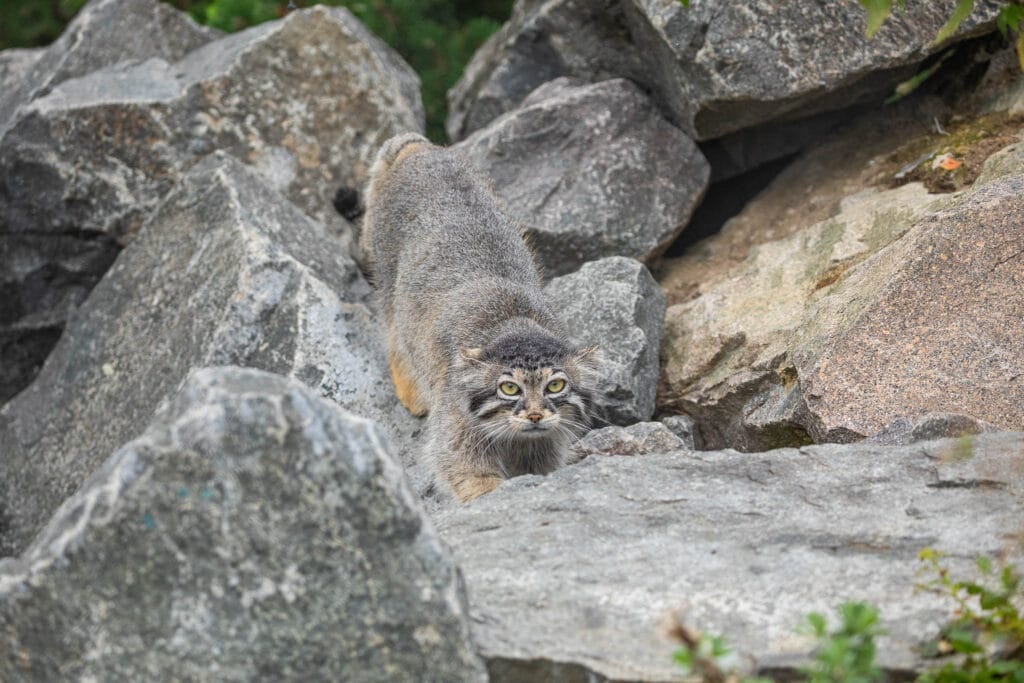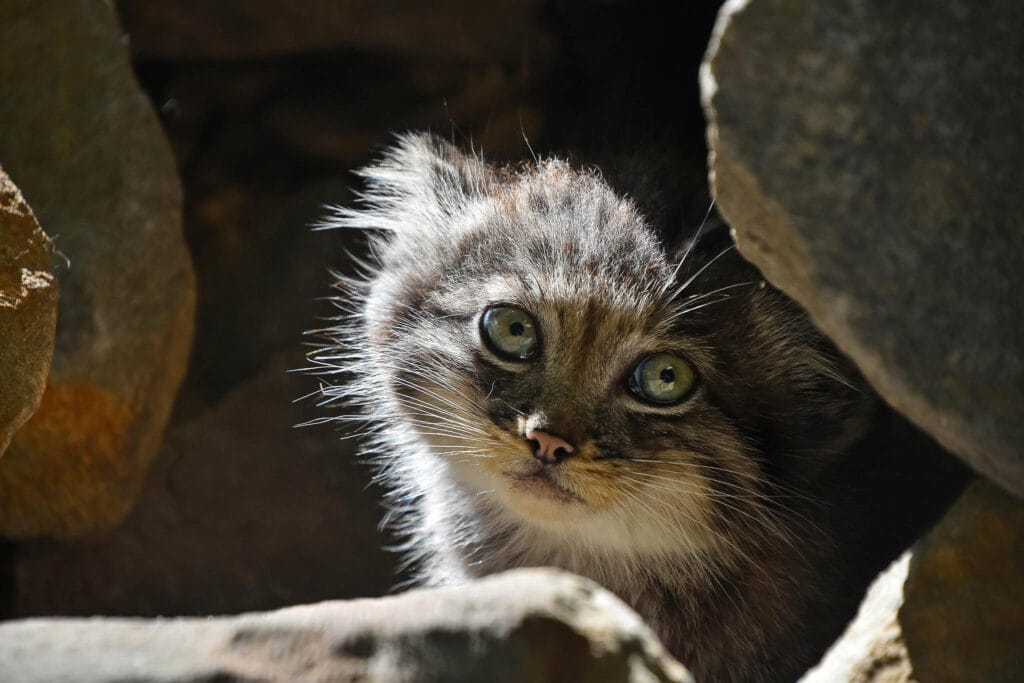Physical description of Pallas’ Cats
The pallas’s cat has a very distinctive head. The structure of the skull has many noticeable differences from other cats, which comes across to us as having a broad face and a large forehead. The ears are small and don’t protrude very high, giving the cat a low profile and allowing it to blend in better when it crawls through the steppe stalking prey.
Given that it lives in freezing winter temperatures, the Pallas’ cat’s fur is long and dense. It is mostly grey. The back is somewhat striped, and the tail is as well. The distinctive forehead also has a slightly silvery color compared to the regular grey.
As mentioned, the Pallas’ cat has a prominent forehead, giving it the look of something like a stereotypical bouncer, and its stocky build, short legs and long underbody fur just add to this image. This build helps to keep it close to the ground, which is essential when it stalks prey in its open steppe habitat. It is a midsize cat with a body length of about half a meter and another 30 cm for its tail.
There is some variation in color across the range of the Pallas’ cat. There are three subspecies based on fur color. The negripectushas a silvery winter coat and lives in the snowier areas of the cats’ range, such as Tibet and Nepal. The ferrugineus from the Caspian Sea area has a lot more orangey rust color in its coat. The name type subspecies, the Otocolobus manul manul, is the regular grey with black stripes on the back and tail.
Distribution and habitat of Pallas’ Cats
The Pallas’ Cat is probably one of the best-known of the non “Big Cat” species. Living across the sparsely populated central Asian plateau, its range covers Iran to Mongolia.
There are also many living in zoos around the world, which has brought some internet fame.
The Pallas’ cat, also called Manul, lives in the steppe at high altitudes. In a lot of regions at altitudes up to 5000 m, snow is common, but the Pallas’ cat avoids these areas and prefers to live in habitats with much less snowfall, such as the drier Gobi desert in Mongolia.

Pallas’ Cat behavior
Due to its nocturnal lifestyle, it is hard to study the Pallas’ cat, but it is visible and active at dusk and dawn. Despite living in a very open habitat, the cat is capable of blending in very well, its fur offering good camouflage. During the day, the manul tends to hide and sleep in areas where it is protected, like in between rocks and even in the abandoned dens of other animals that live nearby, like foxes.
The Pallas’ cat is not too timid but is not a fighter either and tends to hide when threatened.
What do Pallas’ Cats eat?
The prey of the Pallas cat is obvious if you know the area. There isn’t much that shares its habitat and is of suitable size. Small rodents are its primary prey. The cat sometimes eats birds as well, if they are available. It is the pika that makes up the majority of its diet, as they are among the most numerous small rodents on the steppe.
Mating and Parental care of Pallas’ Cats
These cats can live for ten years or more and are born in litters of 3 or 4 and sometimes more. They have been known to start hunting at quite a young age relative to other cats – from three months onwards.
In general, the manul is a solitary cat.
Impact of Pallas’ Cats on the human economy
The one economic benefit for humans that has been reported is that the Pallas’ cat hunts rodents in outer and inner Mongolia, where the bubonic plague is still endemic. As such, the cat helps to keep the rodent population down and possibly prevent the spread of the disease to humans.
The fur was, at one time, an economic benefit, but hunting is now prohibited in most of its range.
Like other cats its size, it might prey on the poultry of small, isolated farmers. However, the cat is rare, and human populations in its range are equally rare, so it generally has no impact on humans.

Conservation status and human impact on Pallas’ Cats
The IUCN status is near threatened because numbers are decreasing, and the numbers of Pallas’ cats were not that high to begin with.
Across Russia and China, the cat is no longer hunted, but it was previously hunted in relatively large numbers for its luxurious fur.
From the 1980s onwards, hunting has been banned within its range, but there are other threats. The biggest of which, as with all wildlife, is habitat destruction. It takes a somewhat different form in the wild, open and sparsely habited steppe. The rodents that the manul preys on are receding in numbers. One of the reasons for this is poisoning, as they are considered pests, especially in areas where they carry disease. While a lack of prey is an issue, eating poisoned prey is an even greater threat to the cat.
Other important information about Pallas’ Cats
There are three subspecies.
Otocolobus manul manul
Otocolobus manul ferrugineus
Otocolobus manul nigripectus
Possibly, there is more literature on the cat in Chinese, but for the moment, I cannot find much info about wild Pallas’ cat’s habits.










